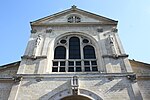Jules Joffrin (Paris Métro)

Jules Joffrin (French pronunciation: [ʒyl ʒɔfʁɛ̃]) is a station on Line 12 of the Paris Métro in the Clignancourt district and the 18th arrondissement. It is located in Montmartre, between the town hall of the 18th arrondissement and the Notre-Dame de Clignancourt church. The station opened on 31 October 1912 as part of the extension of the Nord-Sud company's line A from Pigalle. It was the northern terminus of the line until 23 August 1916 when it was extended to Porte de la Chapelle. On 27 March 1931 line A became line 12 of the Métro. The station was named after Jules François Alexandre Joffrin (1846–1890) who was a councillor of the 18th arrondissement and a député.
Excerpt from the Wikipedia article Jules Joffrin (Paris Métro) (License: CC BY-SA 3.0, Authors, Images).Jules Joffrin (Paris Métro)
Rue Ordener, Paris Quartier de Clignancourt (Paris)
Geographical coordinates (GPS) Address Nearby Places Show on map
Geographical coordinates (GPS)
| Latitude | Longitude |
|---|---|
| N 48.892437 ° | E 2.344782 ° |
Address
Place Jules Joffrin
Rue Ordener
75018 Paris, Quartier de Clignancourt (Paris)
Ile-de-France, France
Open on Google Maps









